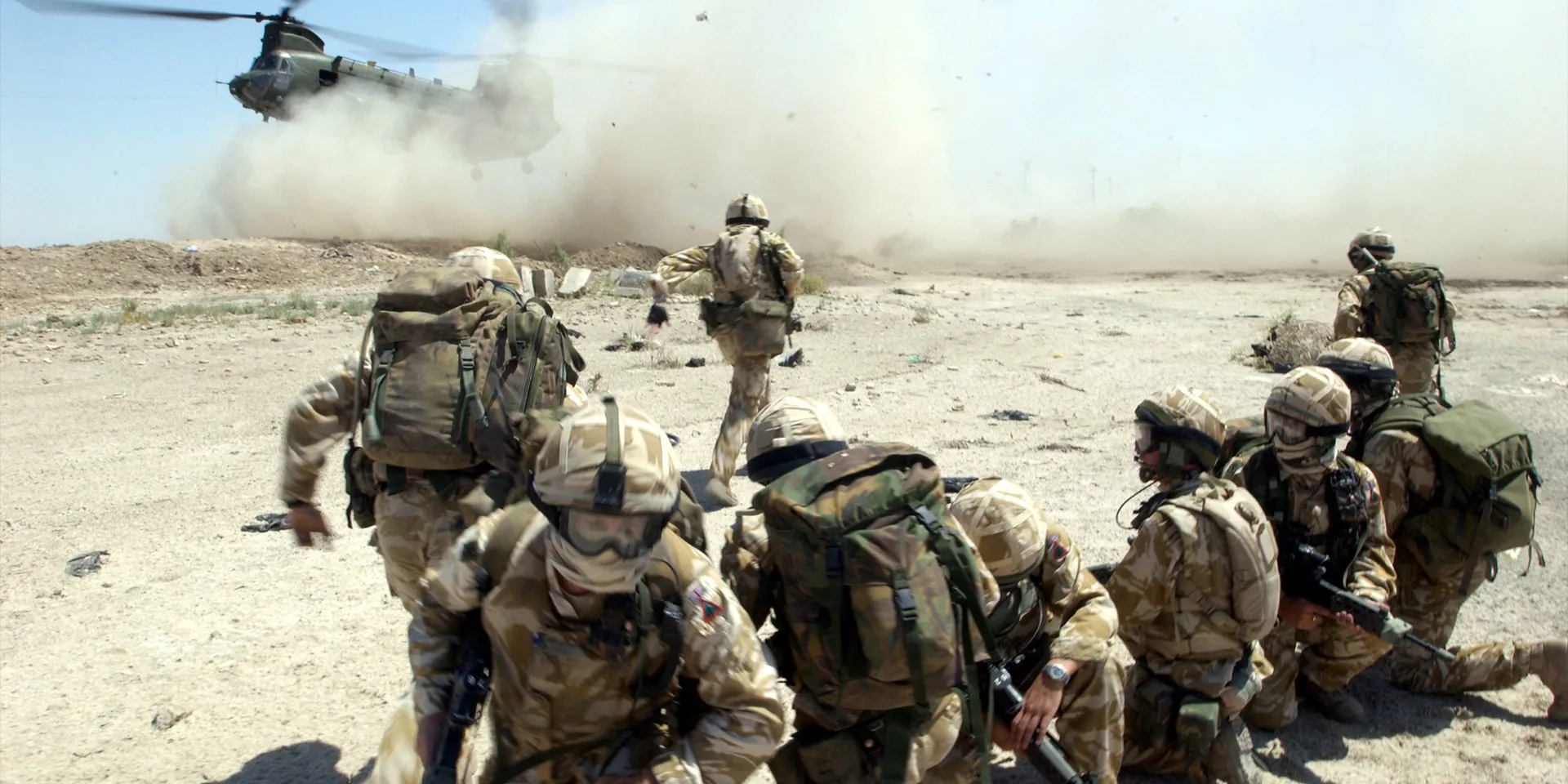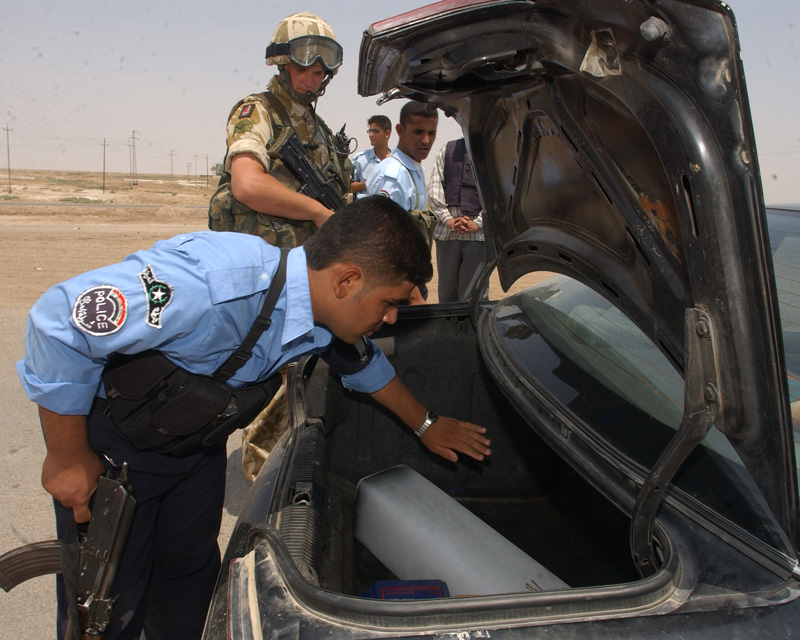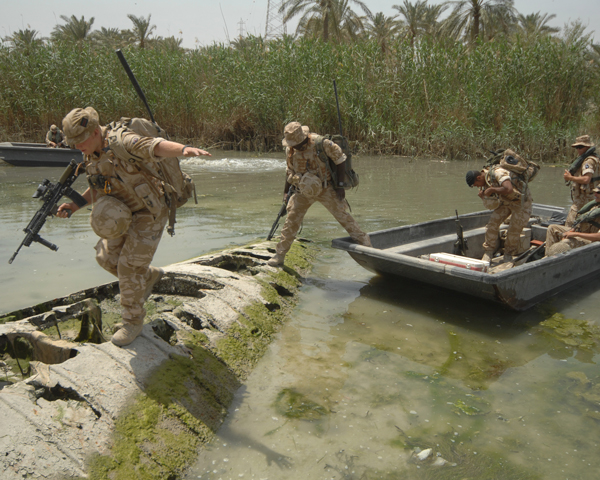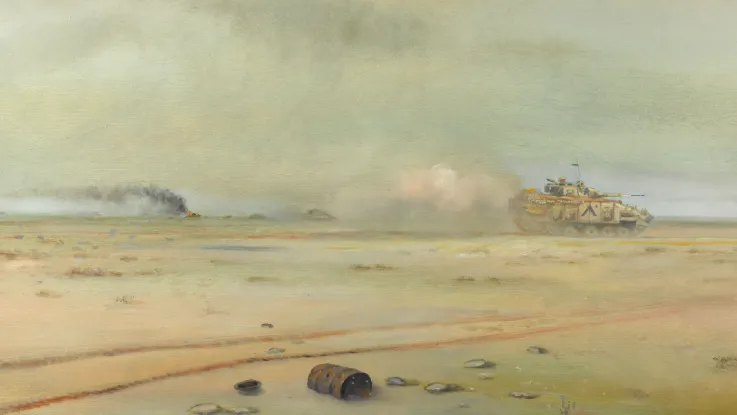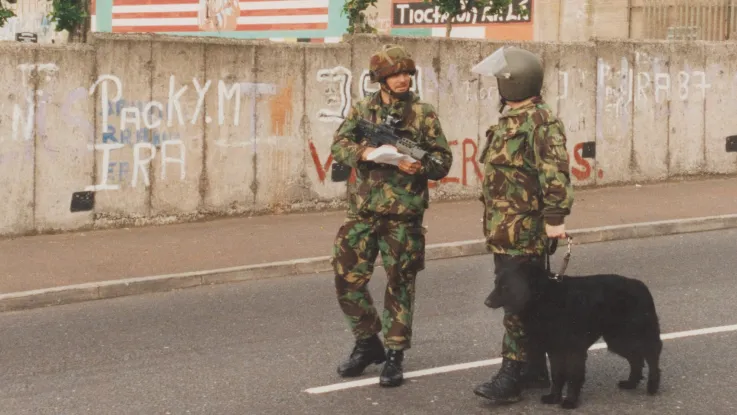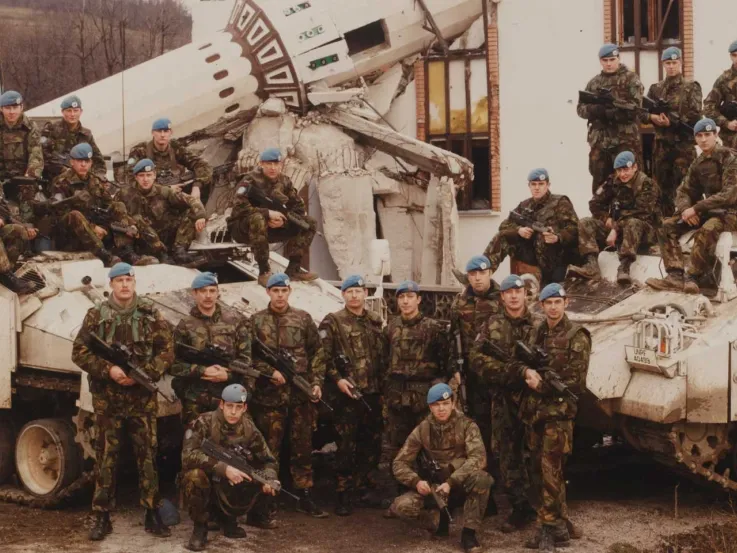Invasion
In March 2003, British and coalition forces took part in the invasion of Iraq. After a month of combat operations, they had occupied the country and deposed its ruler, Saddam Hussein. They now faced the more difficult task of stabilising and securing the nation.
Power vacuum
Paranoid about internal dissent, Saddam had repeatedly purged and systematically terrorised his military. In 2003, the regime’s forces quickly collapsed, abandoning areas like Maysan Province prior even to the arrival of coalition forces. This left a dangerous power vacuum.
Planning for the invasion had been so constrained by time that little attention was paid to how Iraq would be managed if Saddam was successfully removed. There was also a failure to comprehend how the inequalities relating to ethnicity and religion, inherent within Saddam’s Iraq, would affect the country, once the regime’s leadership was removed.
This would be compounded by the new US-controlled administration’s decision to disband Iraq's armed forces and exclude former Ba’athists from military and public office.
‘They can one day be an insurgent, and next day be a normal local. And actually not even on a daily basis, they can do it minute by minute. So the guy you see with a mobile phone on the street corner who is telling people where you are so they can fire an IED, can melt into a crowd with no problem... Conventional war, you know the person you’re fighting wears a different uniform to you, his vehicles are different colours, they’re different shapes, so it’s easy to tell enemy from friendly, easy to tell civilians apart from enemy as well, but unfortunately in this counter-insurgency we’re involved in... you know the insurgent melts into the population easily... so it makes our job a lot harder to identify who is friend or foe.’Major Fidelix Datson, Royal Artillery — 2009
Insurgency
A violent insurgency developed. Initially centred on the 'Sunni Triangle' around Baghdad, Fallujah and Tikrit, the uprising eventually spread to Najaf, Kut, Nasiriyah and Basra. Among the groups involved were former Ba’athists, the remnants of Saddam’s Fedayeen paramilitaries, nationalists and a variety of tribal and religious militias.
The administration’s policy of excluding Ba’athists resulted in ex-Iraqi military personnel being readily available to share their expertise and to take advantage of the substantial caches of abandoned weaponry and ammunition.
Jihadis
US President George W Bush had tried to associate Saddam Hussein’s regime with Al Qaeda to help justify the invasion of Iraq. Ironically, this connection was realised as the developing chaos in Iraq accelerated the influx of foreign fighters.
These included experts in improvised explosives and guerrilla tactics, as well as jihadist proponents of suicide terrorism, keen to target westerners and any Iraqis whom they regarded as apostates.
Stabilisation
The UK government, facing growing controversy over the decision to go to war, had planned to withdraw the bulk of its forces, leaving only a single replacement brigade. But British troops in the south were now engaged in a security and stabilisation operation in the four provinces under their control. Here, they established bases, mounted patrols and checkpoints.
The British forces endeavoured to improve the situation for the local population, reconstructing schools and re-establishing the local police. But their efforts were hampered by diarrhoea, vomiting bugs and heat-related casualties.
Deterioration
A delay in the arrival of specialised civilian staff, and a lack of reinforcement from allied contingents, made their work even harder. The growing numbers of Iraqis being held in detention increased local discontent, and the effect of inevitable changeovers in coalition military personnel contributed to a deterioration in the situation.
On 22 June 2003, 1st Battalion The Parachute Regiment was undertaking weapons searches in Majar al-Kabir, in Maysan Province. Civil unrest boiled over into mob violence and an isolated unit of Royal Military Police involved in mentoring Iraqi police was attacked and killed.
Insurgent groups and militias escalated their campaign of violence. They seized territory to show their power and to demonstrate the weakness of coalition forces and the perceived illegitimacy of the occupation. Attacks on contractors and infrastructure were designed to create an ungovernable space where these new forces could hold sway.
MNF-I
The US-led Multi-National Force - Iraq (or MNF-I) had a mandate from the United Nations (UN) to combat former regime extremists and terrorists, and to organise, train and equip Iraqi security forces until 2007. While there was an objective to create a stable democratic state, there was a fundamental lack of political strategy for Iraq, compounded by questions over legitimacy and a lack of cultural awareness.
In July 2003, Major-General Graeme Lamb took command of British forces in southern Iraq. His broad objective was to create a safe environment where Iraqis could gain control of their own future, thereby allowing coalition forces to withdraw.
19 Brigade was deployed to undertake Operation Telic 2, a daunting task given the size of the area involved and the deteriorating political situation. The brigade included battalions from the Queen’s Lancashire Regiment, the King’s Own Scottish Borderers and the King’s Regiment, and was bolstered by a substantial number of reservists.
Unrest
Growing civil unrest, crime and increasing attacks on British forces in Basra and Maysan deflected these fresh troops from reconstruction tasks designed to pacify and win over the ‘hearts and minds’ of the Iraqi populace. The British ‘soft posture’ approach to counter-insurgency, which contrasted with the use of overwhelming force by US forces, became less viable.
In August 2003, fuel shortages led to rioting across the southern region and British forces were again targeted. Emergency measures restored fuel and power, which calmed the situation. But the attacks continued. On 14 August, 19 Brigade suffered its first fatality from an improvised explosive device (IED). Four more service personnel were killed on 23 August.
The British, helped by a surge in personnel, launched night raids and anti-smuggling operations in September. The alleged abuse of Iraqi prisoners by British soldiers during this period would become public in 2004.
Relief in Place
The new US Coalition Provincial Authority’s plan to deliver a democratically elected Iraqi government by the spring of 2005 provided the British Army with a timeline that they could work to. The training and rotation of troops in Iraq could be planned and executed more effectively. This was illustrated by 20 Armoured Brigade’s relatively smooth deployment, or Relief in Place (RIP), which was a significant logistical challenge.
The length of tours in Iraq was determined by a number of factors, not least the Army's desire to prevent personnel from spending extended periods away from their families. The Army also wanted to safeguard the ongoing programme of training and development. This had to be adapted to allow not only for operational tours, but also pre-deployment training, transition and acclimatisation in the Middle East, as well as ‘decompression’ on a unit’s return.
Although units could return to Iraq for second or third tours, it has been argued that the six-month tour - which included ‘Reception, Staging and Onward Integration’ and two weeks' leave - resulted in a lack of continuity and impacted on effectiveness.
Short-termism in relation to operational tours and the overall strategy in Iraq, as well as a succession of new commanders intent on making their mark, raised concerns, particularly in regard to working with the re-established Iraqi forces and other allies.
Rising
While US forces focused on ex-regime and Sunni Muslim insurgents, a growing threat developed from deeply dissatisfied Shia groups. The Shia uprising of Spring 2004, led by the cleric Muqtada al-Sadr, resulted in his ‘Mahdi Army’ militia capturing parts of Sadr city, Najaf and Nasiriyah.
Over the next three months, more than 1,500 militiamen, several hundred civilians and dozens of coalition soldiers were killed as the Americans and their allies gradually took back lost ground.
Ambushes
As the uprising spread, ambushes in Amarah increased. In Basra, bases were mortared and police stations were hit by suicide bomb attacks. Lieutenant-Colonel Matt Maer, the commander of 1st Battalion Princess of Wales’s Royal Regiment, was ambushed on 18 April 2004, travelling in a Land Rover in Amarah.
The British went on the offensive, recalling armoured vehicles and mounting a sweep of Amarah. May and June saw a number of fierce engagements involving British troops. It was during this period that Private Johnson Beharry of the Princess of Wales’s Royal Regiment won the Victoria Cross for ‘valour of the highest order’.
A ceasefire was eventually called by Muqtada al-Sadr. But attacks by militia and insurgent groups continued, and the use of ever-more-deadly IEDs increased.
Bracken
In October 2004, British forces moved north in support of the US assault on Fallujah. Operation Bracken saw the Black Watch Battle Group engaged in operations mounted from Camp Dogwood. The unit suffered losses as patrols came under IED and suicide attacks.
UK special forces and the Royal Air Force (RAF) continued to assist US forces in central and northern Iraq. Here, Al Qaeda-affiliated fighters were fuelling and exploiting the sectarian violence between Sunni and Shia populations.
New outbreak
In early 2005, hostilities with the Mahdi Army and its allies, aided by Iran and the Lebanese Hezbollah group, broke out again. British forces were engaged in heavy fighting in Amarah, with the CIMIC House - the centre for Civil-Military Co-operation - coming under siege. Lieutenant-Colonel Maer launched another sweep of Amarah with armoured columns supported by air strikes.
Guerrilla warfare
Most engagements with the militia and insurgents were on a relatively small scale, reflecting the nature of what was becoming a bitter guerrilla war. Incidents could, however, escalate into major firefights.
Operations against coalition targets took the form of attacks on convoys using mines, or vehicle-borne or static IEDs. These were often hidden on roadsides, buried in the ground or in piles of rubbish.
Coalition soldiers were also ambushed by snipers and fighters using machine-guns and rocket-propelled grenades.
Attacks
Soft-skinned vehicles used for patrolling were a favourite target. And the continued use of Land Rovers by British forces became a controversial issue.
Mortar or rocket attacks were carried out against coalition bases or installations associated with the new administration. Insurgents would fire a few mortar rounds or rockets and then move positions to avoid coalition air strikes.
Some groups claimed to restrict their attacks to the 'occupying' forces, while others had little regard for civilians. Insurgents also targeted Iraqi 'collaborators' and foreign contractors using car bombs, kidnapping and suicide attacks.
New government
In December 2005, Iraq held its first democratic elections in several decades. Although they were a success, the transition to a stable government proved difficult. The new prime minister, Nouri al-Maliki, was hostile to the British and undermined their operations in the south. The training of Iraqi security forces, disrupted by the Shia risings, became a priority.
Shia militia
Sectarian and internecine violence increased. In the south, the new Iraqi authorities were openly hostile to the continued presence of coalition troops and attempted to protect allied militia leaders.
Some Shia were more amenable to Iranian assistance. Their tactics and IEDs became increasingly more sophisticated with the use of infra-red detonators and armour-penetrating projectiles. British troops and officials in Maysan and Basra were their primary target.
Attacks
On 16 July 2005, three members of The Staffordshire Regiment were killed in an attack on their Snatch Land Rovers, while patrolling in Amarah. On 30 July, a Foreign and Commonwealth Office vehicle was targeted near Basra, resulting in the deaths of two people.
British troops targeting militia leaders in Basra for arrest became embroiled in controversy. The media captured the moment a hostile crowd petrol-bombed a British Warrior, which was providing security for the rescue of two Special Air Service soldiers apprehended in Basra by Iraqi security forces.
Adapting
Confronted with an increasingly hostile administration and populace, and with the Iraqi Police infiltrated and unreliable, and potential no-go areas developing, British forces had to adapt their tactics.
Surveillance operations were mounted with the assistance of local interpreters, who risked their lives to work with coalition forces. When intelligence was available, strike operations were launched to apprehend resistance leaders, confiscate weapons and gather further intelligence.
By mid-2006, competing militias and insurgent groups were increasingly well-organised and equipped. On 6 May 2006, a British Lynx helicopter over Basra was destroyed with a ground-to-air missile.
Withdraw to bases
In 2006, British military forces deployed to Helmand Province in Afghanistan. Air Chief Marshal Sir Jock Stirrup, the new Chief of the Defence Staff, assessed the situation in Iraq and decided to direct his focus and finite resources towards Afghanistan instead. The completion of a full transition to Iraqi control and the withdrawal of British forces now became the priority.
As if to hasten the withdrawal, the militias increased their attacks on British bases and patrols. Offensive operations did not cease, but forces were largely withdrawn from Maysan to concentrate efforts on Basra in the summer of 2006.
Desert patrols on the Iranian border continued, a decidedly more popular duty with British troops than service in Basra or Amarah.
Sinbad
The new British commander in Basra, General Richard Shirreff, brought in reinforcements, secured support from the Americans and tried to gain the cooperation of the Iraqi administration to establish a level of security in Basra. This would allow effective reconstruction and development to occur.
Operation Sinbad (2006-07) involved British troops working with available Iraqi forces to secure areas, and allow surveys and repairs to be carried out on police stations, schools and essential utilities.
Surge
In Autumn 2006, the British embarked on the withdrawal from bases in Basra under their new commander, Major-General Jonathan Shaw.
At the same time, US General David Petraeus launched a new strategy that involved increasing forces in Iraq and retaking urban centres. The ‘surge’ strategy was designed to stabilise the situation in Iraq, and to avoid the scheduled withdrawal being perceived as a military defeat for the United States.
British forces were still under attack in Basra and were taking increasing numbers of casualties. Even their armoured Warrior vehicles were now falling victim to new IEDs.
‘When I arrived, roadside bombs, improvised explosive devices, there was probably one every week to ten days. By the time I left Iraq, four, five months later whatever it was, there was probably one a day in Basra... By the time my battalion went out there – I didn’t go with my battalion – a year later, there was several every day, and they’d improved the technology to be these explosively formed projectiles which could pierce all our armoured vehicles. I was really glad they weren’t around whilst I was there.’Corporal Ryan Alexander, 1st Battalion The Royal Anglian Regiment — 2009
New vehicles
Upgrades were carried out on Warriors and Challenger tanks, and new armoured patrol vehicles, like the Mastiff, began to be deployed. But a continued lack of effective IT hardware and software continued to cause problems.
Shaw, like Shirreff before him, responded to attacks on his troops in a robust fashion, launching effective strike operations and ambushes. Special forces targeted increasingly active Iranian insurgent teams.
Agreement
The British handed all but one of their bases in Basra over to Iraqi control in Spring 2007, and withdrew to the expanded and fortified base at Basra International Airport.
The last remaining outpost within Basra, held by 4th Battalion The Rifles, became the focus of ferocious militia attacks. These attacks and counter-strikes by British forces continued into the summer, with combat casualties rising to their highest level in the campaign.
General Shaw, with US approval, worked towards a localised political solution to end the cycle of violence. Contact was made with elements of the Shia militia who were resistant to Iranian influence. The agreement did not end violence in and around Basra, but it did calm the situation.
Offensive operations were halted, troop movements were restricted, and prisoners released. The British pulled out of their last base without casualties and restricted their operations to security, mentoring and border patrols.
New conflict
The settlement in the south became an issue in 2008, when the Iraq government began to move against Muqtada al-Sadr and the Shia militias he controlled. As British forces focused on withdrawal, Iraqi forces launched the Charge of the Knights operation to clear out the militias.
The staunch resistance the Iraqi regular forces faced in Basra was blamed in part on the British withdrawal from the city. US and British forces were drawn into the fight, providing special forces, armour, air support and advisory teams that embedded themselves with Iraqi units.
To avoid a descent into civil war across Iraq, a ceasefire was brokered. Fighting continued, but the apparent withdrawal of Iranian backing reduced the power of the Shia militias. British forces now adopted the US approach to training Iraqi forces with teams deployed to their bases.
'I think we had at least two or three attacks a day towards the end of the tour. So in many ways as soon as the siren went off, we would hit the ground, and again wait for the attack to finish… when I got home, I watched a Panorama programme about Iraq, and the siren went off, and the next thing I know I’m laying on the living room floor, and the wife’s looking at me like I’m strange. Again, it’s Pavlov’s dog, hear the noise, hit the ground, so again it was very much ingrained in to you.'Major Chris Carling, Royal Electrical and Mechanical Engineers — 2009
Support
US and British Military Transition teams continued to work with the increasingly confident Iraqi Army and special forces, helping to plan Iraqi-led operations and providing armour and close air support.
By the end of April 2008, Iraqi forces controlled Basra, and with US support started operations to clear Amarah of militias.
Drawdown
At the end of 2008, with attention switching to the escalating conflict in Afghanistan, British Prime Minister Gordon Brown confirmed the date for the withdrawal from Iraq.
On 30 April 2009, a ceremony was held at the British base at Basra International Airport to commemorate the British, allied and civilian dead, who had lost their lives in Iraq since 2003.
The Americans and the British Training and Advisory Mission remained in Iraq until 2011, but the last Operation Telic personnel left in May 2009.
Islamic State
After Operation Telic, Iraq experienced further internal conflict, including the evolution of the Islamic State (IS) group. IS occupied territory in both Syria and Iraq. However, by early 2019, its ‘caliphate’ had been systematically dismantled and its forces killed, captured or dispersed by US-backed forces.
The British role in the anti-IS campaign included air-strikes and humanitarian aid. The British Army also helped train Kurdish and Iraqi troops in infantry skills, weapons maintenance, counter-IED methods, and medical and engineering skills.
The cost
Between 2003 and 2009, around 140,000 men and women served in Iraq as part of Operation Telic. By the end of operations, 179 British personnel had been killed, and many more wounded.
The violence unleashed by the invasion and subsequent insurgency led to the deaths of at least 250,000 Iraqis and created millions of refugees.
Inquiry
Wreathed in controversy, the decision to go to war became the subject of an extended official inquiry. Tony Blair and his administration were widely criticised for joining the United States’ invasion of Iraq in 2003. They were also accused of failing to effectively plan, direct and support the military on the ground or to plan for the occupation and rebuilding of Iraq.
The search for Weapons of Mass Destruction (WMD), the original pretext for the invasion, uncovered no hidden arsenal of chemical or biological weapons.
Public opinion
While politicians took the brunt of the criticism, the leadership of the Armed Forces and the Ministry of Defence were also blamed for the way the campaign was run and for the perceived delay in procuring and deploying vital equipment.
The British public remained broadly sympathetic to service personnel. However, as information was released or leaked to the media, soldiers' behaviour came under increasing scrutiny, criticism and, in some cases, the subject of legal action.
On their return home, many soldiers were struck by the general lack of public awareness regarding what they had achieved and experienced while serving in Iraq.

